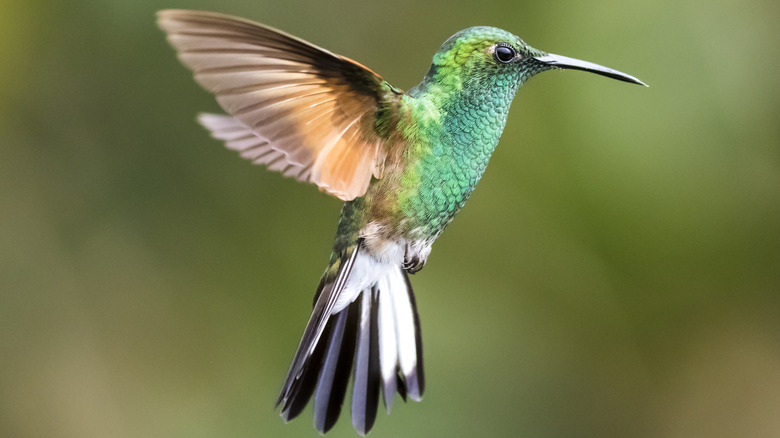The Flowering Perennial That Hummingbirds Will Keep Coming Back To
Hummingbirds can burn up to 12,000 calories every day, so they need to eat a lot of sweet nectar to make up for it. Beardtongue (Penstemon australis) is among the hummingbirds' favorite nectar-rich flowers, and it will keep hummingbirds coming back to your yard year after year. Beardtongues have an avid following among some gardeners, too. They even have their own dedicated group – the American Penstemon Society — founded in 1946 by fans of the flower. Members gather every year for an annual meeting to discuss the plant, exchange photographs, and observe the flower blooming in the wild.
Pollinators, however, might be the beardtongue's biggest fan. Bees love it so much that they will climb nearly all the way in for the nectar, so often only their rear ends are visible. Hummingbirds can't get enough of beardtongue, either, but they don't need to climb in. A hummingbird's long beak and tongue are perfectly suited for the beardtongue's tube-like blossoms. Hummingbirds prefer tubular blooms in general.
Of course, beardtongues are one of many flowers hummingbirds seek out in the garden. You also can grow red bottlebrushes (Melaleuca citrina) to keep hummingbirds coming back to your yard with this unique red-blooming plant. Beardtongue flowers come in more colors, though, like white and pink. With more than 270 varieties of penstemons native to North America, you'll find a bloom that's perfect for your yard. Keep on reading for the best suggestions on how to grow this hummingbird favorite.
Grow beardtongue in these easy steps
Beardtongue does best in USDA Plant Hardiness Zones 5 through 9, so make sure you don't have too cold a winter before you set out to plant. Beardtongue loves the heat and will thrive with sun or partial shade. It's even drought-resistant. Some penstemon varieties prefer to be grown from seed, not from a small sprout, so check seeding instructions before germinating. For those that prefer to grow from seed, plant in just a quarter of an inch below the surface in the late fall or winter. These seeds likely will need a cold weather plunge or stratification to germinate.
Keep in mind, beardtongue is a short-lived perennial, so it might need to be replanted after a few years. While pruning or deadheading beardtongue isn't absolutely necessary, it can increase the number of flowers during the spring and summer. You can learnhow to prune beardtongue properly with just a few simple tips. Since it's a perennial, you'll want to clear away all dead growth before the onset of winter, which will decrease the chance pests or disease take hold the following spring.
Beardtongue can also be prone to white, powdery mildew on its leaves, among other penstemon leaf diseases. So be sure to provide plenty of circulation and not let any penstemon plant get too crowded in the flower bed. You'll want to keep beardtongue healthy and happy in your garden so the hummingbirds come back year after year.

